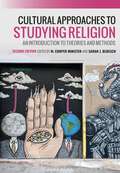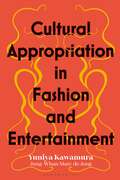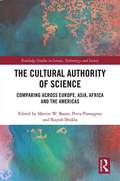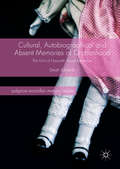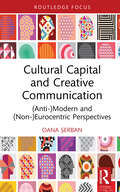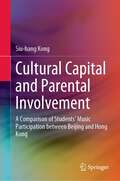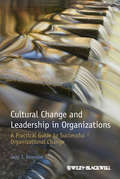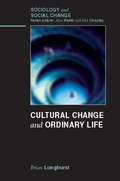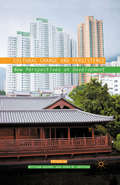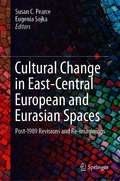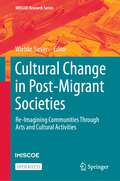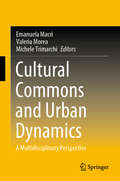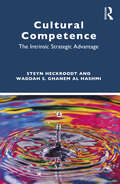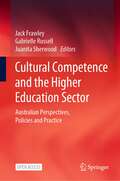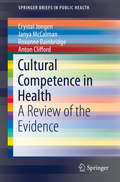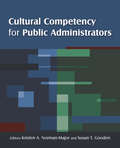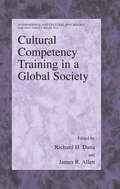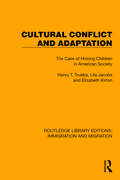- Table View
- List View
Cultural Approaches to Studying Religion: An Introduction to Theories and Methods
Examining the analytic tools of scholars in religious studies, as well as in related disciplines that have shaped the field, this updated textbook includes cultural approaches from anthropology, history, literature, and critical studies in race, sexuality, and gender.Each chapter is written by a leading scholar and includes:the biographical and historical context of each theoristtheir approaches and key writingsanalysis and evaluation of each theorya list of key termssuggested further readingPart One: Comparative Approaches considers how major features such as taboo, texts, myths, and ritual work across religious traditions. This section explores the work of Mary Douglas, Phyllis Trible, Wendy Doniger, Catherine Bell and, new to this edition, Tomoko Masuzawa, whose contributions reveal the colonialist assumptions of the comparative, world religions model.Part Two: Examining Particularities analyzes the comparative approach through the work of Alice Walker, Charles Long, and Caroline Walker Bynum, who all suggest that the specifics of race, body, place and time must be considered.Part Three: Expanding Boundaries examines Gloria Anzaldúa's language of religion, as well as the work ofJudith Butler on performative, queer theories of religion, Saba Mahmood, whose work considers postcolonial religious encounters, secularism, and the relationship between “East” and “West”. New to this edition is Jasbir Puar's work on work on affect, gender, sexuality, and disability.Along with a list of key terms, each section now includes an introduction highlighting the contributions of each thinker and their relation to previous theories that dominated the field.
Cultural Appropriation in Fashion and Entertainment
by Yuniya Kawamura Jung-Whan Marc JongIs it ever appropriate to “borrow” culturally inspired ideas? Who has ownership over intangible culture? What role does power inequality play? These questions are often at the center of heated public debates around cultural appropriation, with new controversies breaking seemingly every day. Cultural Appropriation in Fashion and Entertainment offers a sociological perspective on the debate, exploring appropriation of cultures embedded in race, ethnicity, class, sexuality, and religion in entertainment as well as the clothing, textiles, jewelry, accessories, hairstyles, and tattoos we wear. Case studies are drawn from K-pop, Bollywood dance, J-pop, Bhangra music, Jamaican reggae, hip hop and EDM fashion to explore how, when, and why cultural borrowing or appreciation can become cultural appropriation. There's also discussion of subcultural territories that extend beyond geography, race and ethnicity, such as cosplay and LGBTQI+ communities.By providing a range of global perspectives on the adoption, adaptation, and application of both tangible and intangible cultural objects, Kawamura and de Jong help move the conversation beyond simply criticizing designers and creators to encourage nuanced discussion and raise awareness of diverse cultures in the creative industries.
Cultural Appropriation in Fashion and Entertainment
by Yuniya Kawamura Jung-Whan Marc JongIs it ever appropriate to “borrow” culturally inspired ideas? Who has ownership over intangible culture? What role does power inequality play? These questions are often at the center of heated public debates around cultural appropriation, with new controversies breaking seemingly every day. Cultural Appropriation in Fashion and Entertainment offers a sociological perspective on the debate, exploring appropriation of cultures embedded in race, ethnicity, class, sexuality, and religion in entertainment as well as the clothing, textiles, jewelry, accessories, hairstyles, and tattoos we wear. Case studies are drawn from K-pop, Bollywood dance, J-pop, Bhangra music, Jamaican reggae, hip hop and EDM fashion to explore how, when, and why cultural borrowing or appreciation can become cultural appropriation. There's also discussion of subcultural territories that extend beyond geography, race and ethnicity, such as cosplay and LGBTQI+ communities.By providing a range of global perspectives on the adoption, adaptation, and application of both tangible and intangible cultural objects, Kawamura and de Jong help move the conversation beyond simply criticizing designers and creators to encourage nuanced discussion and raise awareness of diverse cultures in the creative industries.
The Cultural Authority of Science: Comparing across Europe, Asia, Africa and the Americas (Routledge Studies in Science, Technology and Society)
by Martin W. Bauer Petra Pansegrau Rajesh ShuklaThe cultural authority of science is the authority that is granted to science in any particular context. This authority is as much a matter of image and perceived legitimacy as of statutory guarantee. However, while authority can be charismatic, based on tradition or based on competence, we would assume that science aims to be an authority of competence. To what extent does science have the last word, or stand above opinion on public issues? This Indo-European led collaboration aims to map the cultural authority of science, and to construct a system of indicators to observe this ‘science culture’ based on artefacts (science news analysis) and espoused beliefs and evaluations (public attitude data). Indeed, through a series of studies the authors examine the cultural authority of science in light of the challenges posed by European, Asian, African and American developments and debates. In particular, two main ideas are examined: the ‘Lighthouse’ model, whereby science is shining into a stormy sea of ignorance and mistrust; and the ‘Bungee Jump’ model, which demonstrates how science occasionally experiences a rough ride against a backdrop of goodwill. Presenting expertise in discourse analysis, computer-assisted text analysis and largescale survey analysis, The Cultural Authority of Science will be of interest to a global audience concerned with the standing of science in society. In particular, it may appeal to scholars and students of fields such as sociology of science, science communication, science studies, scientometrics, innovation studies and social psychology.
The Cultural Authority of Science: Comparing across Europe, Asia, Africa and the Americas (Routledge Studies in Science, Technology and Society)
by Martin W. Bauer Petra Pansegrau Rajesh ShuklaThe cultural authority of science is the authority that is granted to science in any particular context. This authority is as much a matter of image and perceived legitimacy as of statutory guarantee. However, while authority can be charismatic, based on tradition or based on competence, we would assume that science aims to be an authority of competence. To what extent does science have the last word, or stand above opinion on public issues? This Indo-European led collaboration aims to map the cultural authority of science, and to construct a system of indicators to observe this ‘science culture’ based on artefacts (science news analysis) and espoused beliefs and evaluations (public attitude data). Indeed, through a series of studies the authors examine the cultural authority of science in light of the challenges posed by European, Asian, African and American developments and debates. In particular, two main ideas are examined: the ‘Lighthouse’ model, whereby science is shining into a stormy sea of ignorance and mistrust; and the ‘Bungee Jump’ model, which demonstrates how science occasionally experiences a rough ride against a backdrop of goodwill. Presenting expertise in discourse analysis, computer-assisted text analysis and largescale survey analysis, The Cultural Authority of Science will be of interest to a global audience concerned with the standing of science in society. In particular, it may appeal to scholars and students of fields such as sociology of science, science communication, science studies, scientometrics, innovation studies and social psychology.
Cultural, Autobiographical and Absent Memories of Orphanhood
by Delyth EdwardsThis book offers an empirically informed understanding of how cultural, autobiographical and absent memories of orphanhood interact and interconnect or come into being in the re-telling of a life story and construction of an identity. The volume investigates how care experienced identities are embedded within personal, social and cultural practices of remembering. The book stems from research carried out into the life (hi)stories of twelve undervalued 'historical witnesses' (Roberts, 2002) of orphanhood: women who grew up in Nazareth House children's home in Belfast, Northern Ireland, during the 1940s, 50s and 60s. Several themes are covered, including histories of care in Northern Ireland, narratives and memories, sociologies of home, and self and identity. The result is an impressive text that works to introduce readers to the complexity of memory for care experienced people and what this means for their life story and identity.
Cultural, Autobiographical and Absent Memories of Orphanhood: The Girls of Nazareth House Remember (PDF)
by Delyth EdwardsThis book offers an empirically informed understanding of how cultural, autobiographical and absent memories of orphanhood interact and interconnect or come into being in the re-telling of a life story and construction of an identity. The volume investigates how care experienced identities are embedded within personal, social and cultural practices of remembering. The book stems from research carried out into the life (hi)stories of twelve undervalued ‘historical witnesses’ (Roberts, 2002) of orphanhood: women who grew up in Nazareth House children’s home in Belfast, Northern Ireland, during the 1940s, 50s and 60s. Several themes are covered, including histories of care in Northern Ireland, narratives and memories, sociologies of home, and self and identity. The result is an impressive text that works to introduce readers to the complexity of memory for care experienced people and what this means for their life story and identity.
Cultural Capital and Creative Communication: (Anti-)Modern and (Non-)Eurocentric Perspectives (Routledge Studies in Social and Political Thought)
by Oana ȘerbanInspired by Bourdieu’s thought, this book explores the notion of cultural capital, offering insights into its various definitions, its evolution and the critical theories that engage with it. Designed for use by students and teachers, it addresses the limitations and expansion of Bourdieu's theory of capital and power, considering the relationship between cultural, social and human capital, the distinctions between capital and capitalism, and the conflicts that exist among theories that have emerged in response to – or can be brought to bear on – Bourdieu’s work. Engaging with the thought of Max Weber, Fernand Braudel, Daniel Bell, Herbert Marcuse, Jean Baudrillard, Theodore Adorno, Max Horkheimer and Gilles Lipovetsky, Cultural Capital and Creative Communication represents the first book to develop a field of research and study that is devoted to cultural capital. Richly illustrated with empirical examples and offering assessment exercises, it will appeal not only to scholars and students of sociology, philosophy and social theory, but also to corporate communities who seek to develop training modules on the increase of their cultural capital.
Cultural Capital and Creative Communication: (Anti-)Modern and (Non-)Eurocentric Perspectives (Routledge Studies in Social and Political Thought)
by Oana ȘerbanInspired by Bourdieu’s thought, this book explores the notion of cultural capital, offering insights into its various definitions, its evolution and the critical theories that engage with it. Designed for use by students and teachers, it addresses the limitations and expansion of Bourdieu's theory of capital and power, considering the relationship between cultural, social and human capital, the distinctions between capital and capitalism, and the conflicts that exist among theories that have emerged in response to – or can be brought to bear on – Bourdieu’s work. Engaging with the thought of Max Weber, Fernand Braudel, Daniel Bell, Herbert Marcuse, Jean Baudrillard, Theodore Adorno, Max Horkheimer and Gilles Lipovetsky, Cultural Capital and Creative Communication represents the first book to develop a field of research and study that is devoted to cultural capital. Richly illustrated with empirical examples and offering assessment exercises, it will appeal not only to scholars and students of sociology, philosophy and social theory, but also to corporate communities who seek to develop training modules on the increase of their cultural capital.
Cultural Capital and Parental Involvement: A Comparison of Students’ Music Participation between Beijing and Hong Kong
by Siu-hang KongThis book uses Pierre Bourdieu’s cultural capital model as a theoretical framework for exploring how students in Beijing and Hong Kong perceive parental influences—their parents’ cultural capital and support—on their participation in musical activities. By studying students’ perceptions of their parents’ cultural capital and support for their musical activities, this book revisits the applicability of Bourdieu’s cultural capital model in the contemporary Chinese context and reveals how inequality in terms of parental cultural capital governs parents’ support and influences the intergenerational transmission of cultural capital, which in turn contributes to inequality in terms of students’ cultural capital.
Cultural Change and Leadership in Organizations: A Practical Guide to Successful Organizational Change
by Jaap J. BoonstraThe need for change within organizations is not uncommon, whether as a result of financial crisis, collaboration issues following an international merger, or other major events. But how can organizations effectively transform themselves? Jaap Boonstra argues that it is not possible to achieve positive strategic change without cultural change, but cultural change is itself not a simple process. So what steps can leaders take in order to tackle cultural change successfully and what are meaningful change strategies? Offering a clear vision on organizational change, Cultural Change and Leadership in Organizations outlines the conditions and factors necessary for an organization’s positive strategic and cultural transformation. Boonstra explores the relationship between culture and leadership, and details ways to effectively combine and organize diverse approaches for strategic and cultural change within organizations. Throughout the text, he combines inspirational and conceptual material with practical examples and concrete interventions for planning and implementing these changes. The text is an invaluable addition for students of MBA and executive MBA programs, as well as a broad range of practitioners.
Cultural Change and Leadership in Organizations: A Practical Guide to Successful Organizational Change
by Jaap J. BoonstraThe need for change within organizations is not uncommon, whether as a result of financial crisis, collaboration issues following an international merger, or other major events. But how can organizations effectively transform themselves? Jaap Boonstra argues that it is not possible to achieve positive strategic change without cultural change, but cultural change is itself not a simple process. So what steps can leaders take in order to tackle cultural change successfully and what are meaningful change strategies? Offering a clear vision on organizational change, Cultural Change and Leadership in Organizations outlines the conditions and factors necessary for an organization’s positive strategic and cultural transformation. Boonstra explores the relationship between culture and leadership, and details ways to effectively combine and organize diverse approaches for strategic and cultural change within organizations. Throughout the text, he combines inspirational and conceptual material with practical examples and concrete interventions for planning and implementing these changes. The text is an invaluable addition for students of MBA and executive MBA programs, as well as a broad range of practitioners.
Cultural Change and Ordinary Life (UK Higher Education OUP Humanities & Social Sciences Sociology)
by Brian LonghurstHow important are the media?How is culture changing?How is ordinary life being transformed?How do we belong?This ground-breaking book offers a new approach to the understanding of everyday life, the media and cultural change. It explores the social pattern of ordinary life in the context of recent theories and accounts of social and cultural change. Brian Longhurst argues that our social and cultural lives are becoming increasingly audienced and performed and that activities in everyday life are changing due to the ever-growing importance and salience of the media. These changes involve people forging new ways of belonging, where among other things they seek to distinguish themselves from others.In Cultural Change and Ordinary Life, Longhurst evaluates changes in the media and ordinary life in the context of large-scale cultural change, especially with respect to globalization and hybridisation, fragmentation, spectacle and performance, and enthusing or fan-like activities. He makes the case that analysis of the media has to be brought into a more thorough dialogue with other forms of research that have looked at social processes.Cultural Change and Ordinary Life is key reading for students and researchers of sociology, media studies, cultural studies and mass communication.
Cultural Change and Persistence: New Perspectives on Development
by William Ascher & John M. Heffron William Ascher John M. HeffronThis book is about the ways that traditional cultural practices either change or persist in the face of social and economic development, whether the latter proceeds primarily from internal or external forces.
Cultural Change in East-Central European and Eurasian Spaces: Post-1989 Revisions and Re-imaginings
by Susan C. Pearce Eugenia SojkaThis book weaves together research on cultural change in Central Europe and Eurasia: notably, Bosnia and Herzegovina, Kazakhstan, Latvia, Poland, Russia, and Ukraine. Examining massive cultural shifts in erstwhile state-communist nations since 1989, the authors analyze how the region is moving in both freeing and restrictive directions. They map out these directions in such arenas as LGBTQ protest cultures, new Russian fiction, Polish memory of Jewish heritage, ethnic nationalisms, revival of minority cultures, and loss of state support for museums. From a comparison of gender constructions in 30 national constitutions to an exploration of a cross-national artistic collaborative, this insightful book illuminates how the region’s denizens are swimming in changing tides of transnational cultures, resulting in new hybridities and innovations. Arguing for a decolonization of the region and for the significance of culture, the book appeals to a wide, interdisciplinary readership interested in cultural change, post-communist societies, and globalization.
Cultural Change in Post-Migrant Societies: Re-Imagining Communities Through Arts and Cultural Activities (IMISCOE Research Series)
by Wiebke SieversThis open access book links the artistic and cultural turn in migration studies to the larger struggle for narrative and cultural change in European migration societies. It proposes theoretical and methodological approaches that highlight how ideas of change expressed in artistic and cultural practices spread and lead to wider cultural change. The book also looks at the slow processes of change in large cultural institutions that emerged at a time when culture was nationalised. It explains how individual and group activities can have an impact beyond their immediate surroundings. Finally, the book discusses how migration researchers have cooperated with arts and cultural producers and used artistic means to increase the effect of their research in the wider public. As such, the book provides a great resource for graduate students and researchers in the social sciences and the humanities who have an interest in migration studies and want to move beyond interpreting the world towards changing it.
Cultural Commons and Urban Dynamics: A Multidisciplinary Perspective
by Emanuela Macrì Valeria Morea Michele TrimarchiToday, cities are being intensively reshaped by unexpected dynamics. The rise and growth of the digital economy have fundamentally changed the relationship between the urban fabric and its resident community, overcoming the conventional hierarchy based on production priorities. Moreover, contemporary society discovers new labour conditions and ways of satisfying needs and desires by developing new synergies and links. This book examines cultural and urban commons from a multidisciplinary perspective. Economists, architects, urban planners, sociologists, designers, political scientists, and artists explore the impact and implications of cultural commons on urban change. The contributions discuss both cases of successful urban participation and cases of strong social conflict, while also addressing a host of institutional contradictions and dilemmas. The first part of the book examines urban commons in response to institutional constraints from a theoretical point of view. The second and third parts apply the theories to case studies and discuss various practices of sustainable planning and re-appropriation in the urban context. In closing, the fourth part develops a new urban agenda as artists imagine it. This book will appeal to scholars interested in the social, economic and institutional implications of cultural and urban commons, and provide useful insights and tools to help local governments and policymakers manage social, cultural and economic change.
Cultural Competence: The Intrinsic Strategic Advantage
by Steyn Heckroodt Waddah S. Ghanem Al HashmiTaking a strategic imperative perspective, this book introduces business leaders to a key differentiator that contributes to competitive advantage and financial sustainability: cultural competence. In a fast-changing and globalized world where organizations are being forced to rethink their strategies, understanding present and future environmental, social, and economic challenges is fundamental to creating a resilient and value-creating business. Combining experience and reflection, this book addresses concepts of organizational cultural competence as an internal differentiator and source of competitive advantage. Most organizations approach differentiation as an external feature of product and/or service delivery. Whereas these are open to imitation, cultural competence, as the internal DNA of an organization, is much more difficult, if not impossible, to imitate. The authors bring to bear their years of experience in corporate roles and as entrepreneurs and academics, sharing views and experiences based on research but also on primary examples, meta-insights, and real-world case studies. Senior leaders and consultants across industries, as well as students of strategy and leadership development, will value this serious and comprehensive guide that explains the importance of cultural competence as a strategic advantage in a global market.
Cultural Competence: The Intrinsic Strategic Advantage
by Steyn Heckroodt Waddah S. Ghanem Al HashmiTaking a strategic imperative perspective, this book introduces business leaders to a key differentiator that contributes to competitive advantage and financial sustainability: cultural competence. In a fast-changing and globalized world where organizations are being forced to rethink their strategies, understanding present and future environmental, social, and economic challenges is fundamental to creating a resilient and value-creating business. Combining experience and reflection, this book addresses concepts of organizational cultural competence as an internal differentiator and source of competitive advantage. Most organizations approach differentiation as an external feature of product and/or service delivery. Whereas these are open to imitation, cultural competence, as the internal DNA of an organization, is much more difficult, if not impossible, to imitate. The authors bring to bear their years of experience in corporate roles and as entrepreneurs and academics, sharing views and experiences based on research but also on primary examples, meta-insights, and real-world case studies. Senior leaders and consultants across industries, as well as students of strategy and leadership development, will value this serious and comprehensive guide that explains the importance of cultural competence as a strategic advantage in a global market.
Cultural Competence and the Higher Education Sector: Australian Perspectives, Policies and Practice
by Jack Frawley Gabrielle Russell Juanita SherwoodThis open access book explores cultural competence in the higher education sector from multi-disciplinary and inter-disciplinary perspectives. It addresses cultural competence in terms of leadership and the role of the higher education sector in cultural competence policy and practice. Drawing on lessons learned, current research and emerging evidence, the book examines various innovative approaches and strategies that incorporate Indigenous knowledge and practices into the development and implementation of cultural competence, and considers the most effective approaches for supporting cultural competence in the higher education sector. This book will appeal to researchers, scholars, policy-makers, practitioners and general readers interested in cultural competence policy and practice.
Cultural Competence in Health: A Review of the Evidence (SpringerBriefs in Public Health)
by Crystal Jongen Janya McCalman Roxanne Bainbridge Anton CliffordThis resource supports evidence-informed approaches to improving the cultural competence of health service delivery. By reviewing the evidence from Australia, Canada, New Zealand and the US, it provides readers with a clear and systematic overview of the interventions and indicators applied to enable health system agencies and professionals to work effectively in various cross-cultural health care situations. The book highlights the importance of cultural competence and describes the current situation in the studied countries; identifies effective approaches and strategies for improving the situation; reviews the indicators for measuring progress; assesses the health outcomes associated with cultural competence; summarizes the quality of the evidence; and presents an evidence-informed conceptual framework for cultural competence in health. Cultural competence is critical to reducing health disparities and has become a popular concept in these countries for improving access to high-quality, respectful and responsive health care. This book provides policy makers, health practitioners, researchers and students with a much needed summary of what works to improve health systems, services and practice.
Cultural Competency for Public Administrators (4x45)
by Kristen A. Norman-Major Susan T GoodenWith a focus on a broad spectrum of topics--race, ethnicity, gender, disability, and sexual orientation at the federal, tribal, state, and local levels--this book equips readers to better understand the complex, real-world challenges public administrators confront in serving an increasingly diverse society. The book's main themes include: What is cultural competency and why is it important? Building culturally competent public agencies; Culturally competent public policy; Building culturally competent public servants; How do agencies assess their cultural competency and what is enough? PA scholars will appreciate the attention given to the role of cultural competency in program accreditation, and to educational approaches to deliver essential instruction on this important topic. Practitioners will value the array of examples that reflect many of the common trade offs public administrators face when trying to deliver comprehensive programs and services within a context of fiscal realities.
Cultural Competency for Public Administrators (4x45)
by Kristen A. Norman-Major Susan T GoodenWith a focus on a broad spectrum of topics--race, ethnicity, gender, disability, and sexual orientation at the federal, tribal, state, and local levels--this book equips readers to better understand the complex, real-world challenges public administrators confront in serving an increasingly diverse society. The book's main themes include: What is cultural competency and why is it important? Building culturally competent public agencies; Culturally competent public policy; Building culturally competent public servants; How do agencies assess their cultural competency and what is enough? PA scholars will appreciate the attention given to the role of cultural competency in program accreditation, and to educational approaches to deliver essential instruction on this important topic. Practitioners will value the array of examples that reflect many of the common trade offs public administrators face when trying to deliver comprehensive programs and services within a context of fiscal realities.
Cultural Competency Training in a Global Society (International and Cultural Psychology)
by Richard H. Dana James AllenCultural competence is more than an admirable goal: it is an essential skill set for mental health professionals working in a diverse global society marked by crisis and trauma. It is essential for clinicians to understand the intricate mix of history and self-concept, identity and tradition that are central not only for ameliorating psychological problems but to foster psychological health and well-being. As the definition of culture takes on broader meanings-at once embracing multiple identities and increasing globalization- Cultural Competency Training in a Global Society brings a vital perspective and practical understanding to clinical, counseling, and school psychologists, as well as to graduate students entering these fields. By describing a comprehensive training model for professional education and practice in the United States with ethnic minority groups, indigenous populations, immigrants, and refugees, this book has relevance for other multicultural societies because the implications are multidisciplinary in focus and potentially international in scope. The existing and emergent global multicultural populations described in this book represent the neglected human faces of economic globalization. Among the topics covered: Requirements for professional training in cultural competency. Research basis for cultural competency training. International resources and their usage in training and practice. Multicultural assessment in the service of intervention. Evaluating cultural competency training.
Cultural Conflict and Adaptation: The Case of Hmong Children in American Society (Routledge Library Editions: Immigration and Migration #7)
by Henry T. Trueba Lila Jacobs Elizabeth KirtonCultural Conflict and Adaptation (1990) examines the alienation and cultural conflicts faced at school by the children of a small group of Hmong who have settled in La Playa, California. The educational process for these children is an example of cultural conflict and adjustment patterns which may be found in many other populations in the world.
